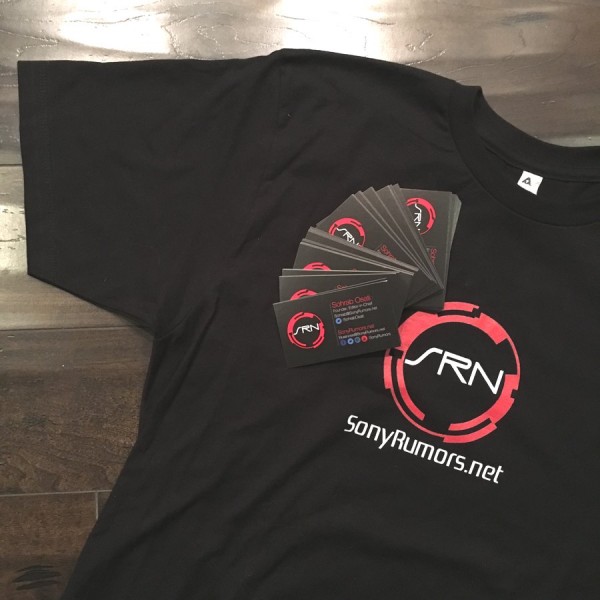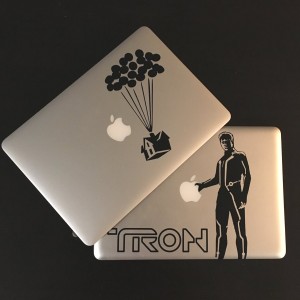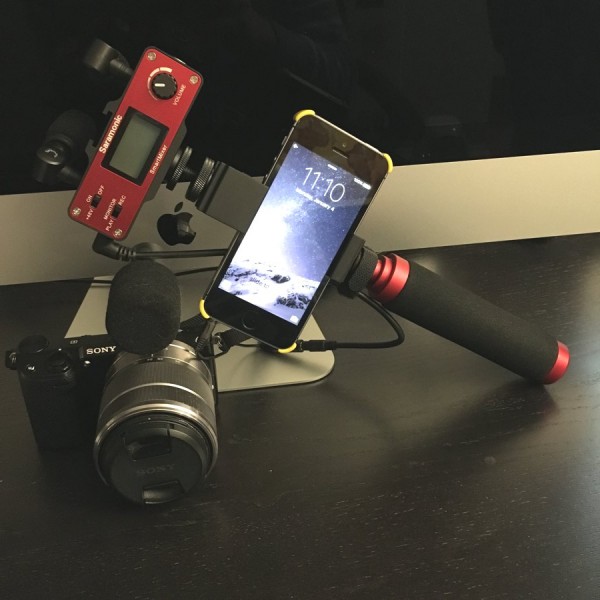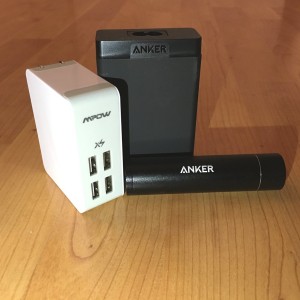
Each year as we head to CES, I try to share with you our journey to the tech mecca and how we plan to cover things. As most long time readers will note, SRN is not a large funded site like Engadget or backed by Sony so not only is the entire show costs upon my own shoulders, but so are the equipments used to cover.
That tends to then make for an interesting dynamic as the equipment I use and purchase needs to versatile enough to cover CES and other similar events while also hopefully being useful in other arenas as well. In addition to the site, make sure you connect with us on all of our social feeds as a lot of times it’s easier to upload pics and videos there versus publishing a full length article around it on here.
After the jump, my CES equipment pile.
Shirts and New Cards
Sure it’s not technically equipment but with so many people coming and going, I thought this would be a good year for Allegra and I to finally have some official SRN shirts. I’m hoping when dealing with other outlets and companies, wearing the shirts will make that initial credentials exchange a bit easier since that’s way easier to spot than the lanyard around our neck.
The new cards are also part of a redesign that I’ve hinted at in other posts. Slated for sometime in 2016, I hope to make the site and its content much sleeker for with less clutter and more focus. The new cards are the start of a redesigned site with small design elements like the font used (Helvetica Neue Normal) being incorporated in the videos from CES and later to the site as well. I’m a firm believer in that it’s the little things that make the biggest difference and I’m hoping the new shirts and business cards help set the tone for the year to come.
 MacBook Pro and MacBook Air
MacBook Pro and MacBook Air
When it comes to events, traveling light with as much power is the holy grail. Between all the other equipment like cameras, phones, chargers, mics etc., a laptop can be quite a bit of extra weight to carry. At the same time, for members of the press, there is a nice large area with pretty good internet speed (last I checked it was around 100Mb down and 40Mbs up) which is crucial for us getting the videos from CES uploaded. That means though that besides all of our gear, we have to carry our laptops with us as well and even with the lightest models around, it still adds up eventually.
One day, all of this work will be possible on an iPad or other similar tablets but with our heavy reliance on Final Cut Pro X and other similar apps (like batch renaming/compression) we’re still sadly tied to the computer. Helping with the grunt work for all of the media we’ll be capturing is a 2TB Seagate USB 3.0 and a backup 500GB FireWire/USB 2.0 homebuilt drive. Editing off the drive also makes switching computers easier and reduces the chance that everything would be lost in the event of something happening to one of the computers.
Camera and Camcorder
I tend to cover CES in two ways – I shoot a majority of our videos on a Sony NEX-5N while the short videos/photos on Instagram/Facebook/Twitter come from whatever iPhone I happen to have that year. This year, it will be the iPhone 6s providing those shots, seeing how its much easier to snap something and upload it on your phone versus needing to sync your camera to your computer and then upload. The biggest problem I’ve had in the years past at CES has been audio. Unfortunately at the time, my options of getting an NEX camera was either the NEX-5N, NEX-6 which only offered small difference compared to my model or the NEX-7 which did offer a mic input at an extra $500. Sure there were other features the NEX-7 had, but none were useful to me.
Since that time, I’ve hoped that 3rd party companies would release hot shoe mics but only Sony has released one. While much better than the onboard mic, it’s no substitute for having a lav mic, nor is the distance all too great. Even worse, if I’m holding the camera and recording with commentary, since the mic is pointed away from me, audio again isn’t the best. To that end, this year I’m trying the device you see below.

Dubbed the Saramonic SmartMixer Professional Recording Stereo Microphone Rig for iPhone & Android Smartphones, this nifty guy allows you to connect your phone with stereo mic input for $149. Best yet, the mics are directional, meaning I can better record myself or create a situation where one mic points forward and the other back at me. I’m currently testing it with an iPhone 5s we had sitting around though depending on how well it goes, I might slip in my iPhone 6s into it. The handheld nature of it also makes hold the phone easier for smoother shots.
Besides that, the rig also allows you to attach handheld mics and even yes, lav mics since they just plug into the phones audio jack. For that purpose, I purchased the
- Sony ECMCS3 Clip style Omnidirectional Stereo Microphone – $16
- Miracle Sound Deluxe Lavalier Lapel Clip-on Omnidirectional Condenser Microphone – $19
- Stony-Edge Microphone/Headset/Headphone Audio Extension Cable – $10
I’ll be doing a review of the Sony ECMCS3 (hello mouthful) later but in a few short tests, I wasn’t all that impressed. If the situation arises that I’ll need a lav mic, I’ll be using the Miracle Sound with the extension. The best thing is that all this equipment is compatible with iOS and Android devices and can go a long way towards improving your work flow and really upping the quality.
Chargers and Battery
Running out of battery sucks and man when you’re at CES do you burn through battery. To that end, I have an arsenal of extra batteries, chargers and USB battery packs to get us through the day. Starting off with our iPhones, I purchased the iPhone 6s Smart Battery Case for both Allegra and myself. This easily doubles our charge and should make things even easier should I decide to use my iPhone in the camera rig. Speaking of battery packs, I’ve also purchased the Anker PowerCore+ mini Aluminum Portable Charger (Lipstick-Sized 3350mAh Power Bank) which is small enough to slip into a pocket or a bag without weighing you down but enough to give you much-needed juice when things are looking dire. That can be found for $13.
 Seeing how finding a free power plug is a challenge, be it at a hotel or show floor, I’ve built up quite a decent arsenal of USB chargers with multiple ports. My favorites include
Seeing how finding a free power plug is a challenge, be it at a hotel or show floor, I’ve built up quite a decent arsenal of USB chargers with multiple ports. My favorites include
- Anker 25W 5-Port Desktop USB Charger with PowerIQ Technology – $12
- Anker PowerPort 4 (40W 4-Port USB Wall Charger) Multi-Port USB Charger with Foldable Plug – $27
Both units make charging multiple pieces of equipment far easier and seeing how almost everything we have, minus our laptops, is USB-powered, both units are a dream for traveling. Best yet, the Anker units offer up to 2.4 amps per port, making them powerful enough to charge an iPad. Many USB hubs and chargers are only 1.2 amps and in turn, take forever to charge the large battery in iPads. The Anker 5-port unit also comes in a 60W variation though that will set you back $36.
I hope you guys had fun with this piece. I know it’s not directly Sony related but I know that whenever I find myself on the other side of the fence, I’m curious as to how people put together their website or project and this was meant to give you a little insight on my work flow. As always if you have any questions, feel free to post them in the comment section below.

You must be logged in to post a comment.